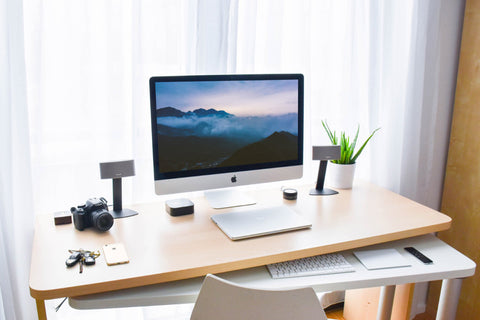Provide a workstation to your remote employee
 GroWrk Team
GroWrk Team
Many people don't turn their cameras on for conference calls these days. When your remote workers turn on their cameras what do you see? Where are they sitting? Do they look comfortable?
Only 7% of Americans worked remotely before Covid. Now the numbers are estimated at more than 40%. Just 54% of Americans had some home office equipment before the pandemic. Those numbers are beginning to change as more companies have begun implementing their own remote work policy. Some employees are guaranteed a remote office with ergonomic furniture. Companies realized that the risk of employee dissatisfaction, chronic pain, and even lawsuit was too overwhelming to ignore this apparent and easily fixable issue.
Furniture items like a standing desk have flown off the shelves since the pandemic hit. Employees went on a spending spree to build their ideal workspace inside their home. However, it can be incredibly expensive to outfit an entire home office on your own.
What is the smart solution to supporting your remote workers with office equipment? We'll answer that in the article below.

Are Employees without Proper Home Office Equipment Satisfied?
The colossal shift to remote work left many people unprepared. A Procurify survey conducted in April found that 32% of its respondents had never worked from home before. These were uncharted waters for many people. They were used to pulling up to their cozy office chair and mingling by the water coolers. Many workers were complicit in working in ad-hoc situations.
They got by the first several months with a stiff chair, a faulty desk and their kids running into video calls. Now after almost a year of working from home the majority of people have become accustomed and their expectations have changed. Remote work is the new normal and people understand it isn't going anywhere.
Despite some of these early struggles, the overall views of home office remain somewhat positive. 76% of people reported in the survey being satisfied with their new situation and have demonstrated increased productivity. It makes sense given some of the obvious perks of remote work like lack of commute and more time with family. This satisfaction is something employers have an opportunity to build upon and use to their advantage for recruitment in their remote workforce.
With more workers attracted to home office positions, companies that offer outstanding benefits packages will get their top choice of eligible candidates from around the world. Currently only a select few companies that were remote before the pandemic offer a wide range of benefits for their remote employees. 69% of those interviewed reported that their companies provided no additional benefits for remote work. 47% say their company has not offered to cover the cost of buying equipment like a work computer, desk, or ergonomic keyboard. 41% also mentioned their companies wouldn't compensate them for the money they have already invested in their home offices.
Companies competing for the best remote workers are simply behind the times in providing this benefit. Suppose your company begins to offer furniture and other equipment to remote workers (a relatively small cost when compared to other benefits packages), in that case, it will immediately reach the top of the list in remote employee career websites.

What are the Health Implications of not providing a workstation for remote employees?
Generally speaking, working from home for some people can be great. They love spending more time with their families, they have time for a run in the mornings, no more stiff suits or extended morning bathroom routines. For others, it's been a bit of a struggle.
The repetition can wear you down over time and many people experience depression, anxiety, and high levels of stress. Employers must be aware of these common mental funks and fatigues and do their best to address them with education and outreach. Companies should make reading materials and information about the signs of depression and stress relieving exercises readily available to employees.
In terms of furniture and equipment, there has been extensive research on the relationship between where we sit and back pain. Posture is difficult to maintain without the proper core strength, and even something as slight as the height of someone's desktop computer can make a big difference in slouching.
When it comes to physical health problems and the home office, almost everyone has the same experience. It's so regular that there are literally online guides for using everyday household objects like rolled-up towels to make working from your kitchen table or your couch more comfortable. In the short term, addressing this issue could help your distributed team out of a lot of discomforts. In the long-term, the implications are even more significant.
Chronic illnesses like carpal tunnel, back pain and significant injuries to the rotator cuffs are never something you want to cause as an employer. The wellness of your employees should be your priority. Injuries sustained over a long period like that are hard to heal and can lead to complications for the rest of their lives. Inadequate home office equipment is also one of the most common claims for workers' compensation and is predicted to be the most common claim among remote employees in the near future.

Do Companies Pay for Internet for Remote Employees? What are the Legal Implications of Not Providing Workstaions?
With the economic shift happening from COVID, it's safe to expect a lot of legislation changes. From stimulus packages to tax breaks, lawmakers will do their best to keep up with the volatile climate left in the aftermath of the pandemic. A surprising front runner at the center of this legislative discussion is the rights of the remote worker.

In the past, remote workers made up a tiny margin of the workforce, and a large percentage of them worked on a freelance basis. Thus, people in the government paid them little attention and allowed them to sort out their contracts between themselves and the companies. Few laws were made specifically addressing remote employees. All of that has changed now. With more and more people working from home, they need to be recognized as legitimate employees that are entitled to the same rights as in-office staff. We already see these laws beginning to come into effect in the U.S. and Europe.
In the U.S., California became the first state to legally require companies that employ remote workers to provide adequate seating when primarily working while seated. California is always at the forefront of progress regarding workers' rights, and more states are sure to follow suit shortly. If it continues, companies won't just have to worry about workers' compensation among their employees but could also face possible fines and legal repercussions.
For now, as long as you don't have remote workers in California, you shouldn't have to worry about out of state remote worker laws. If you're not sure about remote worker laws in your state or the state where your employees are located, try looking it up on the state government website.
International remote worker regulations are proving to be even more strict. In Europe, there has been a slew of new laws for telework in the past few months. Germany has begun discussing making telework a legal right for employees while also offering citizens working from home a tax credit for their increased utility bills. In Spain, they've added remote work to their legal code, and have mandated home office equipment be provided by companies to their remote employees.
In Mexico they have taken it a step further by now requiring a contract between an employer and a remote worker. The contract guarantees compensation for the costs of electricity and internet as well as the right to disconnect when they have reached their working hours for the day. Again, this legislation can only indicate future trends and more reasons to outfit your employees' homes.

What Does Your Remote Employee Need?
There are two options when it comes to supporting your remote staff with the equipment they need. You can either buy it for them or give them a stipend. Both have their advantages and disadvantages, but employees typically prefer stipend. It gives them the freedom to customize this space in their home. You don't want to get a green office chair for that one accountant with a red interior (yikes). However, you can put your company logo on the equipment if you order it in bulk and have it delivered. It's really up to you and the budget/image of your company.
One thing you don't want to do is go through just any generic direct to consumer furniture supply company. These companies are often overloaded and will up their prices with demand. The equipment they offer is low-quality when it's affordable and costly when it's high-quality. To order a bulk shipment of ergonomic office furniture or technical equipment could take months to deliver and will have no guarantees your employees will be satisfied with it.
Instead, you should use a company like Growrk. Growrk enables you to set a budget for all your employees, and they can pick the furniture and equipment themselves. Once they input their address, Growrk will get it delivered to them in 3 business days, free. This will save you or your HR team a lot of trouble and administration headache and allow them to focus on other important things.
If you want an idea of what furniture and equipment to buy your employees, the same survey from Procurify gave the following insights.
Of the employees surveyed about what type of furniture they would prefer:
- A sit/stand desk 18.0%
- An ergonomic chair 15.7%
- A new computer monitor 14.7%
- Headphones 11.5%
- A printer 9.7%
- A laptop stand 9.%
- A wireless keyboard and mouse 7%
- A Keurig coffee maker 6%
- A yoga mat and ball 4.7%
- A high-end water bottle 2%
In the end, we know that ergonomically correct furniture for the home office is a necessity. The problems related to poorly selected furniture and equipment are too significant to be ignored. If you offer this benefit to your employees, you will be at the head of the race in helping the world transition from physical to digital. Remote work (and home office) is here to stay. If you want to stay competitive, then you need to stay up to date. Ensuring that your remote team has proper furniture and equipment is the first step of the race. Get running! __
Want to learn how GroWrk Remote can help you take care of your remote team with ease?







